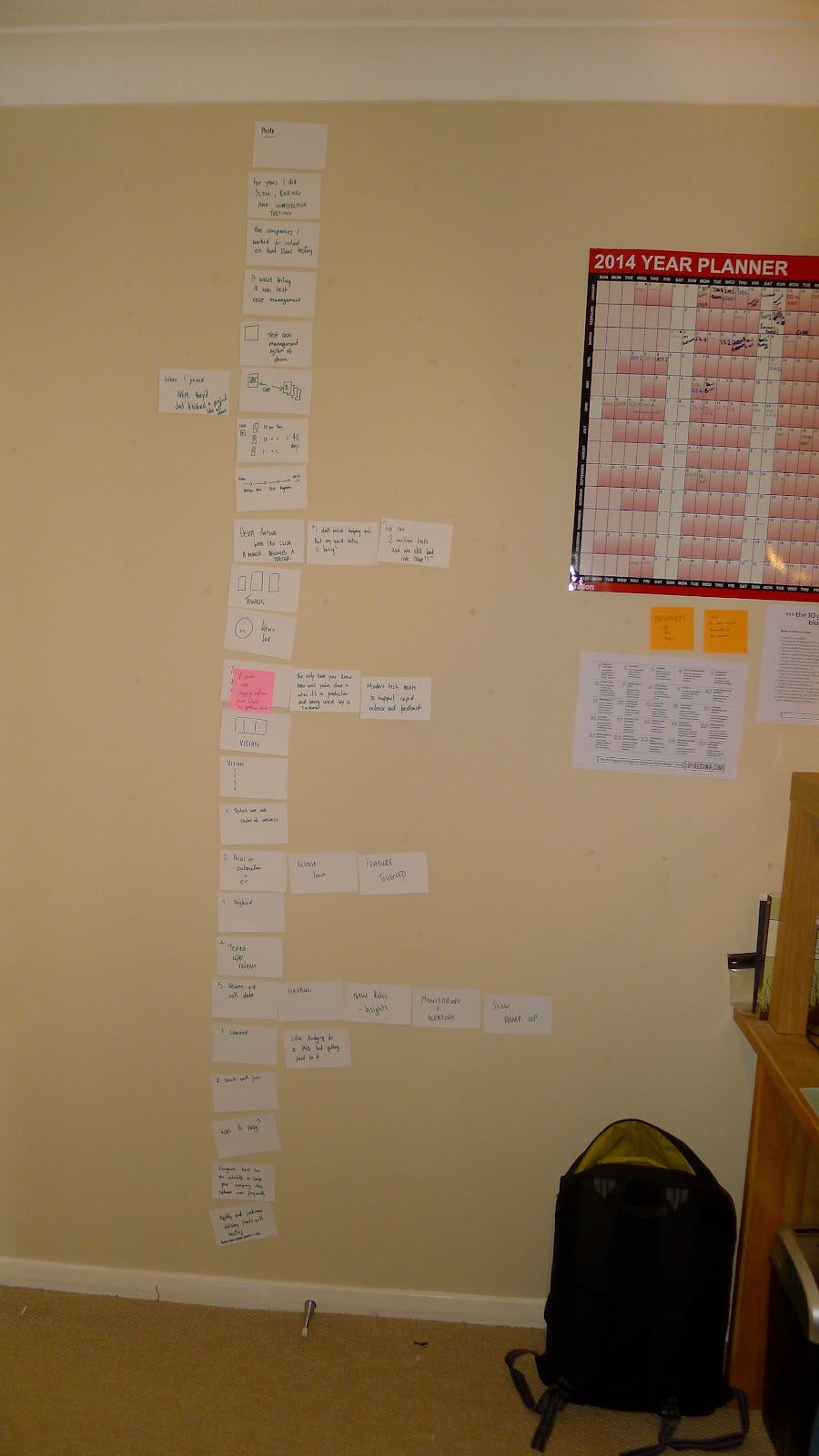CSP 017 - Crafting a Winning Conference Talk Proposal - and getting it selected
A mini guide straight from the Zero to Keynote book
Hey Creative Souls,
I hope you are safe and well. Welcome back to Creative Soul Projects.
Today, how to craft a winning conference proposal (article below, podcast here).
Crafting a Winning Conference Talk Proposal - and getting it selected
You may have the most outstanding and incredible story to tell from the stage, but if you don’t get your conference talk accepted at a conference, nobody will be able to hear it.
The conference submission is the first hurdle, after you’ve got a solid idea of course. Too often though, aspiring speakers don't put enough effort into their submission. Let’s jump in.
Listen to the podcast - read on below.
Where to Look for Calls for Papers (CFPs)
Before you can write a winning proposal, you need to find the right conference to speak at. I’ve seen some brilliant talks get super negative feedback because they were at the wrong conference.
Hence, choosing appropriate conferences for your talk is essential.
There are plenty of places to look for relevant events and their Call for Papers (CFP). The CFP is simply when conference organisers open submissions for talks.
Here's where to find those opportunities:
Your Immediate Industry: Check out industry journals, news sources, local meet-ups, and user groups.
Niche Industries: If you're in a specialised field (e.g., "industrial waste management in hospitals" or "Ruby on Rails for coding websites"), look for niche journals, sites and news.
Social Media: Facebook, LinkedIn, Insta etc – use relevant hashtags and follow interesting people in your community.
Blogs: Keep an eye on your favourite blogs; they often announce upcoming conferences or CFPs.
Your Network: Talk to peers, colleagues who've attended or spoken at events, and people you meet at user groups.
Past Conferences: Review events you've attended in the past – they'll likely have new CFPs opening up.
Pro Tip: CFPs can open anywhere from a few months to a year in advance. To give yourself plenty of time, sign up for conference newsletters and follow their social feeds.
Understanding the Conference Theme
Most conferences have themes. These themes serve as a guide and help organisers brand the event, creating a cohesive storyline for speakers and topics.
Broad Themes: Sometimes themes are really broad, meaning you can likely "shoe-horn" your topic in, no matter what it is.
Narrow Themes: Other times, themes are very specific, especially in niche industries.
Here's the crucial insight: A conference theme is rarely an absolute. There's almost always wiggle room.
If your talk doesn't perfectly fit the theme, there are typically always ways to weave elements of the theme into your idea.
The key takeaway? You can usually find an angle to pivot your idea towards the theme, or at least make a strong case for its relevance.
Crafting a Winning Proposal: My 10-Step Guide
This is where you start crafting your winning proposal. A great proposal is your first impression, and it needs to stand out to get the reviewers to say “Yes, our audience need to see this talk”.
1. Read the Call For Papers (CFP) carefully
Read the CFP multiple times and create a checklist of all important details:
Submission deadline: Put it in your calendar with reminders.
Word/character count: Get this right! There's a big difference, and it's a common mistake people make.
Other requirements: Photo, author bio, links, supporting papers – add these to your to-do list.
2. Schedule Quiet Time for Your Submission
Crafting a good proposal always takes longer than you think. Do not rush it!
This is your best shot at making a good impression. Many budding conference speakers don’t put in the required time to craft a really good proposal.
I’ve been programme chairs and on the submissions review teams - and I’d estimate that at least 75% of submissions are not very good. Rushed, devoid of value and often missing key requests such as bio and photo.
Work Offline: Always draft your proposal in a document editor (like Google Docs or Word) first. This allows you to check word counts, correct spelling, and, most importantly, save your work.
Save a Copy: Keep a copy of every submission. You'll thank yourself later when you're accepted and need to remember what you actually submitted. I once submitted a proposal, didn’t keep a copy and was accepted. I had to email the organisers to ask what I’d submitted…
3. Define Your Purpose, Audience, and Context (PAC)
This is the bedrock of a great talk and a great proposal.
Purpose: What's the goal of your talk? To teach? Inspire? Educate? Inform? Persuade? Entertain? When you get crystal clear about your purpose, you have solid insights for writing your submission.
Audience: Who are you speaking to? Create an "avatar" or "persona" for your ideal attendee. Are they beginners or experts? What industry are they in? The more defined your audience, the better your talk (and proposal) will be. Trying to please everyone usually pleases no one.
Context: Where will the talk be delivered? A huge keynote stage? A small user group? A workshop? Think about the physical setting, time of day, audience's native language, etc. Your proposal should reflect the impact suitable for that context.
Remember PAC for your proposal too.
Your proposal itself has a purpose (to get reviewers to say "YES!"), an audience (reviewers-it is NOT your audience for the talk), and a context (likely anonymised, stripped of formatting).
The reviewers are often volunteers reviewing hundreds of mediocre submissions. They will be tired, they are giving up their own time, they may not fully know the industry itself.
Put yourself in their shoes - what would brighten their day, stand out and make them say yes?
Check out the Communication Superpower Workbook for further rich insights into effective communication.
4. Outline Your Topic and Rough Flow
Before writing the proposal, outline your entire talk at a high level. This helps you:
Identify if you're trying to cover too much.
Move ideas around and remove excess.
Gain clarity on your core message. Can you summarise it in one powerful sentence? If not, refine it!
For this I tend to use two techniques
A digital mind map so I can outline everything - and then quickly move and edit in the tool.
Index cards. I create one index card per sub-topic and can then move them around on my wall. See image below - the prep for a Keynote submission.
5. Write a Powerful Problem Statement
What problem does your talk solve for your audience?
Are they stuck in their career?
Are they lacking specific skills?
Is their business facing a challenge?
Boil your idea down to the essence of the problem it addresses.
6. Outline the Middle Detail at a High Level
Don't worry about detailing the "messy middle" of your talk in the proposal. Keep this high-level. You'll flesh this out once your talk is accepted. You do not need a completed talk at submission time.
7. Draw Out Your Key "Takeaways" or Calls to Action
What do you want people to do or feel when they leave your talk?
Tangible takeaways: "Here is a free guide on my website to bring this topic to life"
Intangible takeaways: "They will be fired up to look at their own work differently."
Many conferences specifically ask for 3-4 takeaways, so give this serious thought.
8. Simplify, Simplify, Simplify (Then Simplify Again!)
Once you have your purpose, audience, context, outline, problem statement, and takeaways, write your proposal, adhering to word limits. Then:
Read around: Read your submission out loud and spot sentences or words you would never use, or are hard to say.
Edit ruthlessly: Remove anything that doesn't add value.
Return and simplify: Keep refining until only the core essence and message remain. Avoid fluff, but don't cut so much that you lose meaning or you spend ages trying to achieve perfection (that’s a trap).
9. Wait
Seriously, wait at least 24 hours before you hit submit. Your brain often works wonders in the background, giving you fresh insights or clarifications after you've stepped away. Make any final changes, simplify again, and then you're ready.
10. Submit and Keep a Copy
You should now have your polished proposal, takeaways, speaker bio, and a professional headshot.
Professional Headshot: This is non-negotiable. It makes a huge impact. No selfies, no beach photos, no blurry shots. Your photo, if your talk is accepted, will be used on the website and marketing materials – make it shine!
Organise Your Files: I keep a Dropbox folder with my profile photos and author bio, and then separate folders for each conference submission. This prevents that awkward moment of forgetting what you submitted! It also allows you to re-use winning submissions for other conferences.
Offline Completion: Answer all submission page questions offline first, then copy and paste into the form. This saves time and ensures you have a record of all the information. Websites can time out - would be a shame to spend ages writing it into the form to then lose it.
Professional Email: Use an email like firstname.surname@yourdomain.com.
Then, click submit. And wait.
Battling Speaker's Remorse
Ah, speaker's remorse. It's like buyer's remorse, but for talks. You submit, you get accepted, and then it hits home: "Holy cow. Now what? Why did I do this?!"
It's a completely normal feeling. Instead of letting panic set in, reframe it:
"I have plenty of time to practice."
"I submitted this talk for a reason – what was it, and why is it important?"
"This will be fun!"
"They liked my talk! That's a huge validation."
Getting accepted is a testament to your idea and your effort. Embrace the opportunity!
Now you need to structure the talk further, write it out, create slides, rehearse, deal with logistics, deal with nerves, present, do a Q&A and more.
All of this is covered in the Zero to Keynote book!
I hope this guide gives you the tools and confidence to craft a winning proposal.
Good luck!
Thanks for reading this article. If you enjoyed this edition of CSP, feel free to share it with others.
Until next time, where I’ll be sharing more ideas about creativity, learning and communication.
Cheers
Rob..
Support Creative Soul Projects
Creative Soul Projects is a reader supported creative outlet.
Your support and membership has helped to create lots of great content, and useful resources for other creative souls, around creativity, communication and personal learning.
If you’d like to support CSP, consider buying the following:
📒 Find more resources, free downloads and guides in the CSP Store.
🕋 Dig into the archive for great content.









